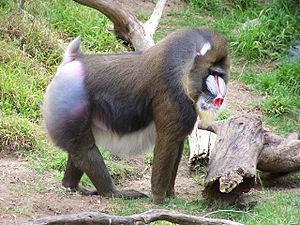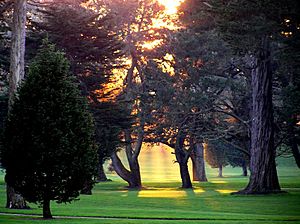- This page was last modified on 17 October 2025, at 10:18. Suggest an edit.
San Francisco Recreation & Parks Department facts for kids
 |
|
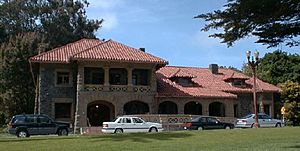 Recreation & Parks Department Headquarters |
|
| Agency overview | |
|---|---|
| Formed | 1871 |
| Preceding agency |
|
| Jurisdiction | San Francisco |
| Headquarters | McLaren Lodge |
| Employees | 850 |
| Agency executives |
|
| Parent agency | City and County of San Francisco |
| Website | http://sfrecpark.org/ |
The San Francisco Recreation & Parks Department is a city group in charge of all public parks and fun places in San Francisco, California. They also manage Sharp Park in Pacifica, California and Camp Mather in Tuolumne County, California.
This department looks after over 4,100 acres of open space. About 3,400 acres are right in San Francisco. They run 179 playgrounds, 82 community centers, nine swimming pools, five golf courses, and many sports courts and fields.
Contents
History of San Francisco Parks
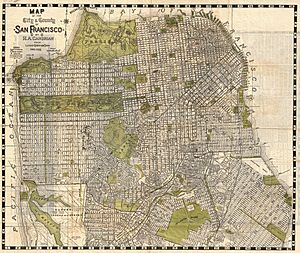
A map of San Francisco in 1932.
A satellite view of San Francisco today.
The San Francisco Recreation & Parks Department started in 1871. People wanted a big public park. So, the city created the Park Commission. Their job was to build Golden Gate Park.
As San Francisco grew, more parks and facilities were added. The city also had a separate group, the Recreation Commission. They managed playgrounds and sports fields. In 1950, these two groups joined together. That's when the San Francisco Recreation & Park Department was formed.
How the Department Works
The mayor of San Francisco chooses the General Manager. This person leads the department.
Phil Ginsburg is the current General Manager. He leads a team of over 850 people. This team includes gardeners, lifeguards, park rangers, and many other experts. They work from the historic McLaren Lodge. This building is at the east end of Golden Gate Park.
Park Commissioners
A group of seven people called Commissioners lead the Recreation & Parks Department. The mayor of San Francisco also chooses them. They serve for four years. The Commissioners pick one of their own to be the President. They meet once a month at San Francisco City Hall.
The current Commissioners are:
- Mark Buell (President)
- Allan Low (Vice President)
- Gloria Bonilla
- Tom Harrison
- Meagan Levitan
- Eric McDonnell
Some people have worried that all Commissioners are chosen by the mayor. They think this might limit different ideas. There have been talks about changing how Commissioners are chosen. One idea was for the mayor and the San Francisco Board of Supervisors to each choose some members.
Cool Places Managed by the Department
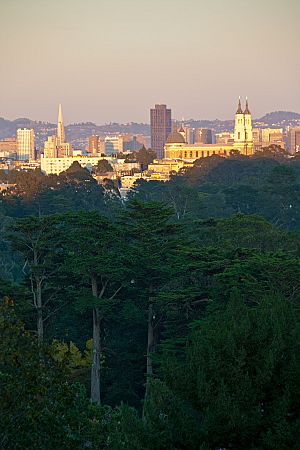
A view of downtown from Golden Gate Park.
The department takes care of over 220 neighborhood parks. They also manage Golden Gate Park. This is the biggest and fifth most visited park in the United States. The Golden Gate National Recreation Area is a federal park. It is managed by the National Park Service.
Golden Gate Park
Golden Gate Park is San Francisco's most important city park. It was first planted in 1871. The park covers 1,017 acres of land. It stretches across the western part of San Francisco. The park is shaped like a rectangle. It is over three miles long from east to west. It is about half a mile wide from north to south.
McLaren Park
McLaren Park is the second largest city park in San Francisco. It is in the southeast part of the city. The park is surrounded by several neighborhoods. These include Excelsior, Crocker-Amazon, Visitacion Valley, and Portola.
Dolores Park
Dolores Park is a city park. It is two blocks south of Mission Dolores. This park is at the western edge of the Mission District. Dolores Park is bordered by 18th Street to the north and 20th Street to the south. Dolores Street is to the east and Church Street to the west.
Coit Tower
Coit Tower is a 210-foot tall tower. It is in the Telegraph Hill neighborhood. The tower is in the city's Pioneer Park. It was built in 1933. The money came from Lillie Hitchcock Coit. She wanted to make San Francisco more beautiful.
San Francisco Zoo
The San Francisco Zoo is owned by the Recreation & Parks Department. A non-profit group called the San Francisco Zoological Society helps manage it.
Kezar Stadium and Pavilion
Kezar Stadium is an outdoor stadium with 10,000 seats. It is in the southeastern part of Golden Gate Park. It used to be home to the San Francisco 49ers and Oakland Raiders. It was updated and made smaller in 1989. The Kezar Pavilion is next to it. This indoor arena was built in 1924 and holds 4,000 people.
Boxer Stadium
Boxer Stadium is a stadium built for soccer. It has 3,500 seats. It was built in 1953 inside Balboa Park. The main team that plays there is the San Francisco Soccer Football League.
Marina Harbor
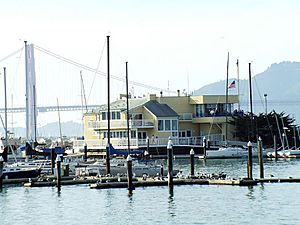
A view of the Golden Gate Bridge from the Marina Harbor.
The Marina Harbor is a public boat dock. It has 671 slips for small boats. It is in the Marina District, across from the Marina Green. The St. Francis Yacht Club and Golden Gate Yacht Club are also located here.
Palace of Fine Arts
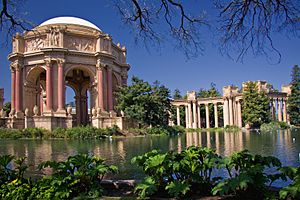
The Palace of Fine Arts was repaired in 2009.
The Palace of Fine Arts is a huge building in the Marina District. It was built for the 1915 Panama-Pacific Exposition. It was made to show off art. It is one of the few buildings left from that event. It is also the only one still in its original spot. It was rebuilt in 1965. The lagoon and walkways were fixed in 2009. The building was also made stronger against earthquakes.
Corona Heights Park
Corona Heights Park is a 15-acre park. It is in the Castro and Haight areas. From here, you can see great views of the city and the bay. The park has the Randall Museum. This museum focuses on science, nature, and art. It also has live animals. The Recreation & Parks Department runs the museum.
Golf Courses
The Recreation & Parks Department has five golf courses. They are in San Francisco and Pacifica, California.
- TPC Harding Park
- Sharp Park in Pacifica
- Gleneagles Golf Course in McLaren Park
- Golden Gate Park Golf Course
- Lincoln Park
Camp Mather
Camp Mather is a summer camp for families. It is in Tuolumne County, California. The camp is near Yosemite National Park. This 337-acre site is very special to the department. Before it was a camp, workers lived here. They built the O'Shaughnessy Dam and Hetch Hetchy Reservoir in the 1920s.
Swimming Pools
The department has nine swimming pools. They are located all over the city.
Park Rangers
San Francisco Park Rangers help people in the city's parks. They patrol in different vehicles. These include cars, ATVs, bikes, and UTVs. Park Rangers work every day of the year, all day and night. Their job is like Park Police in other cities.
Park Rangers patrol over 260 park facilities. These cover 3,400 acres across San Francisco. This includes parks, playgrounds, and sports fields. They also look after natural areas and golf courses.
History of Park Rangers
The San Francisco Park Rangers started in 1874. William Hammond Hall was San Francisco's first Superintendent of Parks. He created the "Park Guard." San Francisco Parks have had their own special safety team ever since. Mr. Hall believed that park officers could help the public in a unique way. This was different from regular city police.
What Park Rangers Do
Park Rangers are often the first to respond to problems. Their jobs include:
- Patrolling all city parks and waterfronts.
- Checking security and parking in parks.
- Making sure park rules are followed. They can also enforce city and state laws.
- Giving out tickets for parking or other issues.
- Catching people doing illegal things.
- Responding to emergencies and alarms.
- Helping other emergency teams like police and paramedics.
Park Rangers also keep the public safe. They protect park wildlife and plants. They can also help in other emergency situations.


